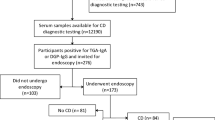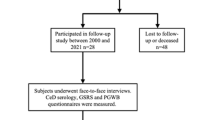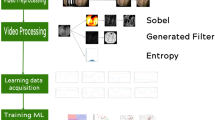Abstract
Intestinal permeability to polyethylene glycol (PEG) (MW 238-590) and serum antigliadin antibody levels (AGA) were studied in children with CD, diagnosed according to ESPGAN criteria. Results of intestinal permeability to PEG (obtained as described previously, NASPG/ESPGAN, 1985:80) were expressed as N1/2, the theoretical polymer length whose recovery is 50% of the maximally recovered polymer (normal > 12). At diagnosis, 0/9 children had normal N1/2 and AGA. Twenty-four/28 children on a G-free diet had normal N1/2. Two children with abnormal N1/2 admitted ingesting G; one had abnormal N1/2 at 56 d but normal after 180 d. Only 5 had normal AGA. After 30 d on a G-free diet, 7/8 children had normal N1/2; but none had normal AGA. After 77 d on the diet, 12/14 had normal N1/2; only 3 had normal AGA. Upon reintroduction of G, N1/2 were abnormal in 17/36 with a tendency towards normal levels with longer re-exposure, although small bowel biopsies were abnormal. Regression analysis between N1/2 and duration of re-exposure to G indicated a significant association (r=0.5, P < 0.05); for every day of re-exposure, N1/2 improved by 0.006 units. Conclusion: Intestinal permeability rapidly improves with elimination of G from the diet and PEG serves as a good indicator to detect children who are noncompliant. In addition, an apparent adaptation of the bowel occurs with prolonged re-exposure to G, and while histological changes persist and AGA remain elevated, intestinal permeability tends to improve.
Similar content being viewed by others
Log in or create a free account to read this content
Gain free access to this article, as well as selected content from this journal and more on nature.com
or
Author information
Authors and Affiliations
Rights and permissions
About this article
Cite this article
Lifschitz, C., Polanco, I. & Nichols, B. CHANGES IN INTESTINAL PERMEABILITY RELATED TO GLUTEN (G) INGESTION IN CHILDREN WITH CELIAC DISEASE (CD). Pediatr Res 20, 696 (1986). https://doi.org/10.1203/00006450-198607000-00066
Issue date:
DOI: https://doi.org/10.1203/00006450-198607000-00066



